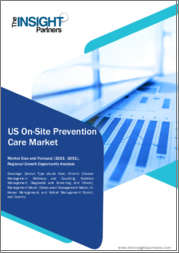
|
시장보고서
상품코드
1666218
미국의 현장 예방 관리 시장 규모와 예측(2021-2031년) : 국가별 점유율, 동향, 성장 기회 분석 - 서비스 유형별, 관리 모델별, 지역별US On-Site Preventive Care Market Size and Forecast 2021 - 2031, Country Share, Trend, and Growth Opportunity Analysis Report Coverage: By Service Type, Management Model, and Geography |
||||||
현장 예방 관리 시장은 2024년 44억 6,000만 달러에서 2031년까지 69억 2,000만 달러에 달할 것으로 예상되며, 2024년부터 2031년까지 6.5%의 연평균 복합 성장률(CAGR)을 보일 전망입니다. 시장 성장을 가속하는 주요 요인으로는 의료 비용 및 보험 청구 감소에 대한 관심 증가, 스트레스와 결근을 줄이기 위한 기업의 웰니스 프로그램 증가 등이 있습니다. 또한, 기업의 전략적 이니셔티브는 예측 기간 동안 시장을 견인할 가능성이 높습니다. 그러나 프로그램 실행에 대한 비용 문제가 시장을 억제하는 요인으로 작용하고 있습니다.
전국적으로 불건강한 근무환경이 증가하고 있으며, 많은 직원들의 삶에 영향을 미치고 있습니다. 장시간 근무, 앉아서 일하는 환경, 압박감 있는 업무 등으로 인해 스트레스와 정신 건강 문제 등 직장 관련 증상이 증가하고 있습니다. 스트레스에 시달리는 직원은 기술 혁신이 저하되고, 고용주 브랜드가 저하되며, 업무 효율성이 떨어집니다. 이러한 상황은 직원의 행복에 영향을 미칠 뿐만 아니라 결근과 생산성 저하로 이어지기 때문에 주요 기업들은 이러한 문제를 완화하기 위해 예방적 의료 솔루션을 찾고 있습니다.
결근률 증가와 인적 자원 관리 비용은 경제에 영향을 미칩니다. 웰빙 솔루션 제공업체인 Workplace Options의 데이터에 따르면, 미국의 결근률은 2021년 3.2%에서 2022년 6% 이상으로 급증할 것으로 예상됩니다. 또한, 2022년 1월에는 약 780만 명의 근로자가 질병, 부상, 의료 문제 또는 스케줄로 인해 결근할 것으로 예상됩니다. 결근률 증가는 고용주와 정부에 대한 우려를 증가시키고 생산성의 지속적인 둔화로 이어지고 있습니다. 결근으로 인한 비용은 직접적 급여 비용과 결근한 직원의 업무를 대신할 동료에게 지급하는 초과근무 수당, 결근을 대신할 임시직 직원에게 지급하는 간접적 비용에 더해져 기업의 의료비용을 증가시킵니다. 건강한 직원은 생산성이 높고, 의욕적이며, 존재감이 있습니다. 현장 예방적 치료는 결근 감소, 의료 관련 중단 감소, 직원 만족도 향상으로 이어져 기업 전반의 성과와 수익 성장에 긍정적인 영향을 미칩니다. 조직은 직원들의 복리후생을 향상시키기 위해 현장 예방관리 프로그램을 채택하고 있습니다. 고용주들은 직원들의 건강 유지와 결근률 감소를 위해 예방 서비스를 제공하는 현장 클리닉을 제공합니다.
스트레스, 불안, 우울증과 같은 정신 건강 질환은 직장에서의 생산성에 심각한 위험을 초래합니다. 많은 고용주들이 직원들의 건강 상태를 개선하고, 생산성을 향상시키고, 결근을 줄이기 위해 직원들을 위한 현장 예방 관리 프로그램(웰니스 프로그램)에 점점 더 많은 노력을 기울이고 있습니다. 현장 예방적 치료의 제공은 이러한 프로그램의 중요한 요소입니다. 예를 들어, 구글은 직원들이 현장 건강관리 서비스와 스트레스 해소 프로그램을 이용할 수 있도록 함으로써 건강과 웰빙을 기업 문화에 통합하고 있으며, 2024년 11월 Vorecol의 기사에서 발표된 American Journal of Health Promotion에 게재된 연구에 따르면, 건강 및 웰니스 이니셔티브가 있는 기업은 직원들의 만족도와 참여도가 향상되고 결근률이 평균 28% 감소했다고 보고했습니다. 마찬가지로 구글의 정신건강의 날(Mental Health Days) 이니셔티브는 직원들이 정신건강을 위해 특별 휴가를 사용할 수 있도록 하는 것으로, 국립산업안전보건연구원의 연구에 따르면 이러한 프로그램은 결근률을 30%까지 낮출 수 있다고 합니다.
직장 내 웰니스 프로그램은 건강 증진을 위한 비용 효율적인 방법입니다. 웰빙 프로그램은 결근률 감소, 직원 유지율 증가, 기업 문화 개선을 통해 고용주에게 더 행복하고 건강한 인력을 제공합니다. Kaiser Family Foundation(KFF)의 Employer Health Benefits 2020 조사에 따르면, 2020년 현재 대부분의 대기업(81%)이 직장 내 웰빙 프로그램을 제공하고 있는 것으로 나타났습니다. 직장 내 웰니스 프로그램을 제공합니다. 또한, 미국 랜드 연구소의 고용주 조사 보고서에 따르면 미국 고용주의 50%가 웰니스 이니셔티브를 추진하고 있으며, 대규모 고용주들은 건강 검진 활동, 건강 위험 식별, 위험 감소 및 건강한 라이프 스타일 촉진 등 최고 수준의 웰니스 프로그램을 시행하고 있습니다. 건강 검진 활동, 건강 위험 식별, 위험 감소, 건강한 생활습관 장려 등 최고 수준의 웰니스 프로그램을 시행하고 있습니다. 미국에서 웰니스 프로그램을 운영하는 고용주의 72%는 검진 활동과 중재 지원을 결합하여 프로그램을 구체화하고 있습니다. 또한, 랜드 대학의 고용주 조사 데이터에 따르면, 고용주들은 직장 내 웰니스 프로그램을 통해 직원들에게 예방적 개입을 지시하고 있으며, 웰니스 프로그램을 제공하는 고용주의 80%가 직원들에게 기존의 주요 건강 위험을 파악하기 위한 검진 프로그램을 제공하고 있는 것으로 나타났습니다.
경쟁사별 분석은 제품 포트폴리오(제품 만족도, 제품 특징, 가용성), 최근 시장 동향(인수합병, 신제품 출시 및 강화, 투자 및 자금 조달, 수상, 계약, 제휴, 인지도, 확장), 그리고 경쟁 구도를 더 잘 이해하고 의사결정을 내리는 데 도움이 되는 지역적 존재를 기반으로 현장 예방 관리 시장을 평가하고 분류합니다. 분류합니다. 이 보고서는 현장 예방 관리 시장의 주요 벤더들의 최근 주요 동향과 혁신에 대해 심층적으로 조사했습니다. 주요 시장 기업으로는 Premise Health Holding Corp, Medcor Inc, Concentra Inc, OccuMed, Marathon Health, LLC, United HealthCare Services, Inc, Mobile-Med Work, Health Solutions, Inc, The Cigna Health Solutions, Inc, The Cigna Health Solutions, Inc. Health Solutions, Inc, The Cigna Group, My Health Onsite, ProgressiveHealth 등이 있습니다.
서비스 유형에 따라 방문 예방 의료 시장은 급성기 의료, 만성 질환 관리, 웰니스 코칭, 영양 관리, 진단 및 검진, 기타로 구분되며, 2024년에는 웰니스 코칭 부문이 가장 큰 시장 점유율을 차지할 것으로 예상됩니다. 관리 모델에 따라 현장 예방 관리 시장은 아웃소싱 관리 모델, 시설 내 관리 모델, 하이브리드 관리 모델로 구분되며, 2024년에는 아웃소싱 관리 모델 부문이 가장 큰 시장 점유율을 차지할 것으로 예상됩니다.
현장 예방관리 시장에서 사업을 전개하는 기업들은 다양한 유기적, 무기적 전략을 채택하고 있습니다. 유기적 전략에는 주로 제품 출시와 제품 승인이 포함됩니다. 무기적 성장 전략에는 인수, 제휴, 파트너십 등이 포함됩니다. 이러한 성장 전략을 통해 시장 기업은 사업을 확장하고, 지리적 입지를 강화하며, 전체 시장 성장에 기여할 수 있습니다. 또한, 인수 및 제휴와 같은 전략은 고객 기반을 강화하고 제품 포트폴리오를 확장하는 데 도움이 됩니다. 현장 예방 관리 시장의 주요 업체들의 주요 발전은 다음과 같습니다.
2023년 8월, 마라톤 헬스(Marathon Health)는 현장 및 근거리 진료소 전문 그룹인 Cerner Workforce Health Solutions(WHS)의 인수를 발표했습니다. 이번 인수를 통해 마라톤의 사업 범위를 확장하고, 더 많은 고용주, 사업장 및 회원들에게 마라톤만의 포퓰레이션 헬스 모델을 제공할 수 있게 됐습니다. 이번 인수는 2023년 8월 1일에 완료되었습니다.
목차
제1장 서론
제2장 주요 요약
- 주요 인사이트
제3장 조사 방법
- 2차 조사
- 1차 조사
- 가설 책정
- 거시경제 요인 분석
- 기초 수치 개발
- 데이터 삼각측량
- 국가 레벨 데이터
제4장 미국의 현장 예방 관리 시장 구도
- PEST 분석
제5장 미국의 현장 예방 관리 시장 - 주요 시장 역학
- 미국의 현장 예방 관리 시장 - 주요 시장 역학
- 시장 성장 촉진요인
- 시장 성장 억제요인
- 시장 기회
- 향후 동향
- 성장 촉진요인과 억제요인의 영향
제6장 미국의 현장 예방 관리 시장 분석
- 미국의 현장 예방 관리 시장 매출, 2021년-2031년
- 미국의 현장 예방 관리 시장 예측·분석
제7장 미국의 현장 예방 관리 시장 분석 : 서비스 유형별
- 급성 치료
- 만성질환 관리
- 웰빙 및 코칭
- 영양 관리
- 진단 및 스크리닝
- 기타
제8장 미국의 현장 예방 관리 시장 분석 : 관리 모델별
- 외부 위탁 관리 모델
- 내부 경영
- 하이브리드 경영 모델
제9장 업계 상황
- 시장 이니셔티브
- 인수합병(M&A)
제10장 기업 개요
- Premise Health Holding Corp
- Medcor Inc
- Concentra Inc
- OccuMed
- Marathon Health, LLC
- United HealthCare Services, Inc.
- Mobile-Med Work Health Solutions, Inc.
- The Cigna Group
- My Health Onsite
- ProgressiveHealth
제11장 부록
LSH 25.03.19The On-Site Preventive Care Market is expected to reach US$ 6.92 billion by 2031 from US$ 4.46 billion in 2024; the market is estimated to grow at a CAGR of 6.5% during 2024-2031. Major factors driving the market growth include rising focus on reducing healthcare costs and claims and increasing corporate wellness programs for reducing stress and absenteeism. Further, strategic initiatives by companies are likely to boost the market during the forecast period. However, cost concerns regarding implementation of programs among the market deterrents.
The unhealthy work environment is rising across the country, affecting the lives of many employees. Workplace-associated conditions such as stress and mental health issues are rising due to long working hours, sedentary work environments, and high-pressure job demands. The presence of stressed employees results in reduced innovation, negative employer brand, and low worker efficiency. These conditions not only affect employee well-being but also lead to absenteeism and decreased productivity, prompting companies to seek preventive care solutions to mitigate these issues.
The increasing absenteeism rate and human resource management costs impact the economy. The rate of absences increases rapidly from 3.2% in 2021 to over 6% in 2022 in the US, as per the data from wellbeing solutions provider Workplace Options. Additionally, about 7.8 million workers missed work because of an illness, injury, or medical problem or appointment, in January 2022. The rising absenteeism rates are increasing concern for employers and governments, leading to a persistent slowdown in productivity. The cost of absences can add up to direct payroll costs and indirect costs, such as overtime for co-workers covering the work of absent employees or payment for temporary workers to cover the absence, thus increasing healthcare costs for the company. A healthier workforce is more productive, engaged, and present. On-site preventive care leads to reduced absenteeism, lower healthcare-related interruptions, and increased employee satisfaction, positively impacting overall company performance and revenue growth. Organizations are adopting on-site preventive care programs to improve employee well-being. Employers are increasingly offering on-site clinics that provide preventive services to help employees stay healthy and reduce absenteeism.
Mental health conditions, such as stress, anxiety, and depression, pose significant risks to workplace productivity. Many employers are increasingly focusing on employee on-site preventive care programs (wellness programs) to improve employee well-being, increase productivity, and reduce absenteeism. Offering on-site preventive care is a key component of these programs. For example, Google integrated health and wellness into its corporate culture by providing employees accessing on-site healthcare services and stress-relief programs. As published in Vorecol's article in November 2024, a study found in the American Journal of Health Promotion reported that companies with health and wellness initiatives experienced an average 28% reduction in absenteeism, along with improvements in employee satisfaction and engagement. Similarly, Google's Mental Health Days initiative allows employees to take dedicated time off for their mental well-being, and a study from the National Institute for Occupational Safety and Health suggests that such programs can reduce absenteeism by as much as 30%.
Workplace wellness programs are a cost-effective way to promote health. Wellness programs yield a happy, healthy workforce for the employer that witnesses decreased absenteeism rates, increased retention, and improved company culture. There is a positive connection between employee wellness and business performance. As per the Employer Health Benefits 2020 survey by KFF (Kaiser Family Foundation), among large companies, most employers (81%) offered some type of workplace wellness program, as of 2020. Additionally, according to the RAND Employer Survey report for the US, 50% of employers in the country are promoting wellness initiatives, and larger employers have top-level wellness programs, which often include wellness screening activities, identifying health risks, and interventions reducing risks and promoting healthy lifestyles. 72% of the employers offering wellness programs in the US substantiate their programs by combining screening activities and intervention support. The RAND Employer Survey data also states that employers direct their employees toward preventive intervention through workplace wellness programs, and 80% of employers offering wellness programs arrange screening programs for their employees for the primary identification of existing health risks.
Thus, increasing corporate wellness programs to reduce stress and absenteeism propels the US on-site preventive care market growth.
The comparative company analysis evaluates and categorizes the on-site preventive care market based on product portfolio (product satisfaction, product features, and availability), recent market developments (merger & acquisition, new product launch & enhancement, investment & funding, award, agreement, collaboration, & partnership, recognition, and expansion), and geographic presence that aids better decision-making and understanding of the competitive landscape. The report profoundly explores the recent significant developments and innovations by the leading vendors in the on-site preventive care market. The key market players are Premise Health Holding Corp, Medcor Inc, Concentra Inc, OccuMed, Marathon Health, LLC, United HealthCare Services, Inc., Mobile-Med Work Health Solutions, Inc., The Cigna Group, My Health Onsite, ProgressiveHealth
Based on service type, the on-site preventive care market is segmented into acute care, chronic disease management, wellness and coaching, nutrition management, diagnostic and screening, and others. In 2024, the wellness and coaching, segment held the largest share of the market. Based on management model, the On-Site Preventive Care Market is segmented into outsourced management model, in-house management, and hybrid management model. In 2024, the outsourced management model segment held the largest share of the market.
Various organic and inorganic strategies are adopted by companies operating in the On-Site Preventive Care Market. The organic strategies mainly include product launches and product approvals. Inorganic growth strategies witnessed in the market are acquisitions, collaboration, and partnerships. These growth strategies allow the market players to expand their businesses and enhance their geographic presence, along with contributing to the overall market growth. Furthermore, strategies such as acquisitions and partnerships helped strengthen their customer base and extend their product portfolios. A few of the significant developments by key players in the On-Site Preventive Care Market are listed below.
In August 2023, Marathon Health announced the acquisition of Cerner Workforce Health Solutions (WHS), a group of dedicated onsite and near-site health clinics. The acquisition expands Marathon's footprint, accelerating the reach of its unique population health model to more employers, locations, and members. The transaction closed on August 1, 2023.
Table Of Contents
1. Introduction
- 1.1 The Insight Partners Research Report Guidance
- 1.2 Market Segmentation
2. Executive Summary
- 2.1 Key Insights
3. Research Methodology
- 3.1 Secondary Research
- 3.2 Primary Research
- 3.2.1 Hypothesis formulation:
- 3.2.2 Macro-economic factor analysis:
- 3.2.3 Developing base number:
- 3.2.4 Data Triangulation:
- 3.2.5 Country level data:
4. US On-site Prevention Care Market Landscape
- 4.1 Overview
- 4.2 PEST Analysis
5. US On-site Prevention Care Market - Key Market Dynamics
- 5.1 US On-site Prevention Care Market - Key Market Dynamics
- 5.2 Market Drivers
- 5.2.1 Rising Focus on Reducing Healthcare Costs and Claims
- 5.2.2 Increasing Corporate Wellness Programs for Reducing Stress and Absenteeism
- 5.3 Market Restraints
- 5.3.1 Cost Concerns Regarding Implementation of Programs
- 5.4 Market Opportunities
- 5.4.1 Strategic Initiatives by Companies
- 5.5 Future Trends
- 5.5.1 Integration of AI and ML technologies
- 5.6 Impact of Drivers and Restraints:
6. US On-site Prevention Care Market Analysis
- 6.1 US On-site Prevention Care Market Revenue (US$ Million), 2021-2031
- 6.2 US On-site Prevention Care Market Forecast and Analysis
7. US On-site Prevention Care Market Analysis - by Service Type
- 7.1 Acute Care
- 7.1.1 Overview
- 7.1.2 Acute Care: US On-site Prevention Care Market - Revenue and Forecast to 2031 (US$ Million)
- 7.2 Chronic Disease Management
- 7.2.1 Overview
- 7.2.2 Chronic Disease Management: US On-site Prevention Care Market - Revenue and Forecast to 2031 (US$ Million)
- 7.3 Wellness and Coaching
- 7.3.1 Overview
- 7.3.2 Wellness and Coaching: US On-site Prevention Care Market - Revenue and Forecast to 2031 (US$ Million)
- 7.4 Nutrition Management
- 7.4.1 Overview
- 7.4.2 Nutrition Management: US On-site Prevention Care Market - Revenue and Forecast to 2031 (US$ Million)
- 7.5 Diagnostic and Screening
- 7.5.1 Overview
- 7.5.2 Diagnostic and Screening: US On-site Prevention Care Market - Revenue and Forecast to 2031 (US$ Million)
- 7.6 Others
- 7.6.1 Overview
- 7.6.2 Others: US On-site Prevention Care Market - Revenue and Forecast to 2031 (US$ Million)
8. US On-site Prevention Care Market Analysis - by Management Model
- 8.1 Outsourced Management Model
- 8.1.1 Overview
- 8.1.2 Outsourced Management Model: US On-site Prevention Care Market - Revenue and Forecast to 2031 (US$ Million)
- 8.2 In-House Management
- 8.2.1 Overview
- 8.2.2 In-House Management: US On-site Prevention Care Market - Revenue and Forecast to 2031 (US$ Million)
- 8.3 Hybrid Management Model
- 8.3.1 Overview
- 8.3.2 Hybrid Management Model: US On-site Prevention Care Market - Revenue and Forecast to 2031 (US$ Million)
9. Industry Landscape
- 9.1 Overview
- 9.2 Market Initiative
- 9.3 Mergers & Acquisitions
10. Company Profiles
- 10.1 Premise Health Holding Corp
- 10.1.1 Key Facts
- 10.1.2 Business Description
- 10.1.3 Products and Services
- 10.1.4 Financial Overview
- 10.1.5 SWOT Analysis
- 10.1.6 Key Developments
- 10.2 Medcor Inc
- 10.2.1 Key Facts
- 10.2.2 Business Description
- 10.2.3 Products and Services
- 10.2.4 Financial Overview
- 10.2.5 SWOT Analysis
- 10.2.6 Key Developments
- 10.3 Concentra Inc
- 10.3.1 Key Facts
- 10.3.2 Business Description
- 10.3.3 Products and Services
- 10.3.4 Financial Overview
- 10.3.5 SWOT Analysis
- 10.3.6 Key Developments
- 10.4 OccuMed
- 10.4.1 Key Facts
- 10.4.2 Business Description
- 10.4.3 Products and Services
- 10.4.4 Financial Overview
- 10.4.5 SWOT Analysis
- 10.4.6 Key Developments
- 10.5 Marathon Health, LLC
- 10.5.1 Key Facts
- 10.5.2 Business Description
- 10.5.3 Products and Services
- 10.5.4 Financial Overview
- 10.5.5 SWOT Analysis
- 10.5.6 Key Developments
- 10.6 United HealthCare Services, Inc.
- 10.6.1 Key Facts
- 10.6.2 Business Description
- 10.6.3 Products and Services
- 10.6.4 Financial Overview
- 10.6.5 SWOT Analysis
- 10.6.6 Key Developments
- 10.7 Mobile-Med Work Health Solutions, Inc.
- 10.7.1 Key Facts
- 10.7.2 Business Description
- 10.7.3 Products and Services
- 10.7.4 Financial Overview
- 10.7.5 SWOT Analysis
- 10.7.6 Key Developments
- 10.8 The Cigna Group
- 10.8.1 Key Facts
- 10.8.2 Business Description
- 10.8.3 Products and Services
- 10.8.4 Financial Overview
- 10.8.5 SWOT Analysis
- 10.8.6 Key Developments
- 10.9 My Health Onsite
- 10.9.1 Key Facts
- 10.9.2 Business Description
- 10.9.3 Products and Services
- 10.9.4 Financial Overview
- 10.9.5 SWOT Analysis
- 10.9.6 Key Developments
- 10.10 ProgressiveHealth
- 10.10.1 Key Facts
- 10.10.2 Business Description
- 10.10.3 Products and Services
- 10.10.4 Financial Overview
- 10.10.5 SWOT Analysis
- 10.10.6 Key Developments
11. Appendix
- 11.1 About The Insight Partners
- 11.2 Glossary of Terms



















